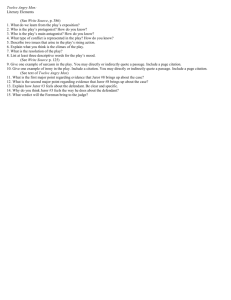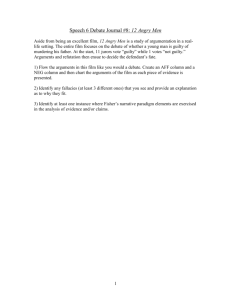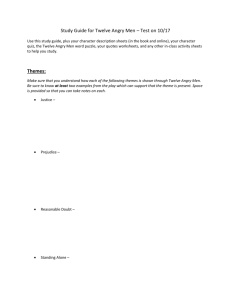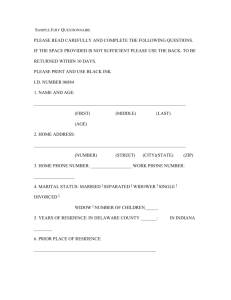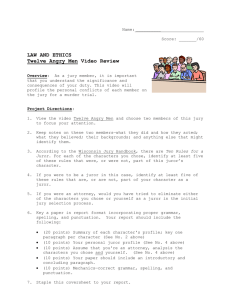Creative training for you & your staff
advertisement
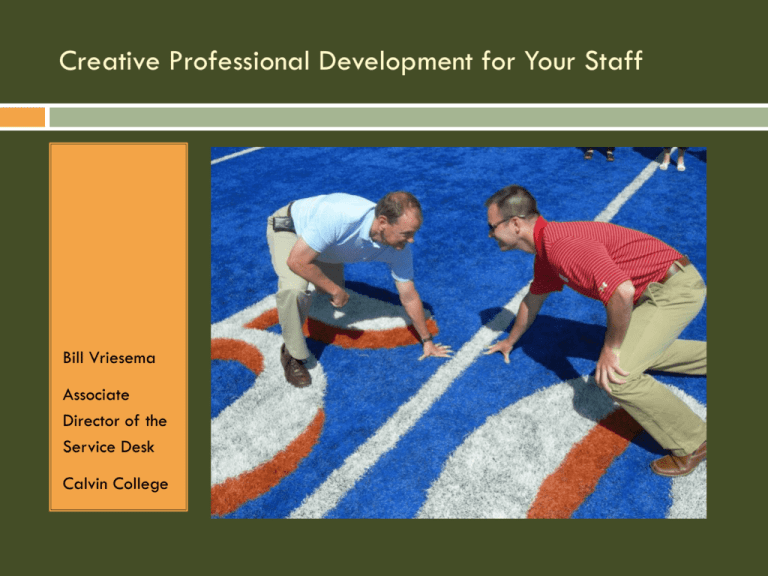
Creative Professional Development for Your Staff Bill Vriesema Associate Director of the Service Desk Calvin College Coming up with ideas What is a current problem? Motivation, morale, burnout, lack of team synergy, leadership issues, interpersonal relationships, troubleshooting skills, communication, etc...? Get ideas from conferences, fellow CCCU, Educause or HDI members, Google searches, books, professional journals, and your staff! (Ask them) Customize and personalize it. Sometimes the workbooks are not appropriate; time away from your physical work place is a big factor. Have realistic expectations of what you expect to get out of it. Sometimes language is the best result. Training I have experienced Discovery Profile The Agile Leader Twelve Angry Men Black Bear For the Love of it First, Break all the rules Trombone Player Wanted Working with Emotional Intelligence Geo-caching Telephone Doctor Speed of Trust The Dream Team Thinking it through Description What concern does it address? (purpose) Learning goals Who is/was the audience? The medium (book, film, speaker, etc…) The activity (and how long it took) Outcomes? Benefits? Resources available Discovery Profile Description The Discovery Profile is a personality test/report that offers a framework for self-discovery What does it address? Developing skills for people to build strong, effective, working relationships with colleagues. Learning goals Understand self Understand others Create better interactions with others Discovery Profile Who was the audience? The medium Online test with Instructor-led discussion of results afterwards. The activity (2-4 hours) Online test weeks before the training session Discussion on background theory of personality styles Test results: interpret our strengths and weaknesses, and how to leverage them for best results. Examples given of how to interact with other personality styles that were different than your own—sometime with humorous results! HelpDesk team; IT Leadership Team; then whole IT Department. Also used for Local HDI Chapter Meeting. Many other college groups did this as well—including Cabinet. Discovery Profile Discovery Profile Outcomes? Benefits? Better understanding of ourselves and co-workers “Permission” to be who we are Builds self-confidence (“I have these strengths...”) We staff project teams with mix of colors/personalities Some staff re-assignments to match personality (ie: put a “green person” on HelpDesk phones several hours/week) Changes way we view communication (ie: He’s in a “red” mood, don’t ask today…) “We need a “yellow” person to lead that social event” We use the “language” daily! Discovery Profile Resources available Discovery Profile http://www.insights.com/LearningSolutions/Tools/ PersonalProfile.aspx Other similar tests DISC Profile http://www.discprofile.com/ Leadership Style Inventory The Agile Leader Using Improvisational comedy to manage unpredictable situations The Agile Leader Description What does it address? A workshop that teaches leaders to use improvisation to help people manage change by improving their ability to act intelligently and with integrity in unpredictable situations. Being able to “think on your feet” as a leader Learning Goals Identify what default behaviors you can use in a moments notice. The Agile Leader Who was the audience? College leaders, supervisors, managers. The medium A local Improv Comedian leads this very interactive workshop (classroom-led with lots of role-playing) The Agile Leader The activity (6-8 hours) This interactive workshop uses a variety of improvisational exercises to allow you to perceive how an agile leader reacts to a changing work environment, and status/power issues within working relationships. The play fostered by the games focuses on using the tools of improvisation in order to promote interactive and purposeful communication to improve collaboration, creativity, and productivity. The Agile Leader Amygdale attack: The Thalamus short circuits decision making by funneling information to the amygdale before the decision making part of the brain (Cerebral cortex) resulting in flight or fight response. The Agile Leader Outcomes? Benefits? Identified some default behaviors Example 1: If someone “drops a bomb on you” ....you can say “I’m sorry, tell me more.” Rather than getting defensive, your apology helps defuse the situation and allows for clarity rather than defensiveness to kick in (or worse, an “amygdale attack” kicks in). Example 2: Your boss says that you will need to support a new service that you clearly do not have resources to do so. Rather than saying “There is no way I can support that!” you might say “Let me see at what level we will be able to support that.” (It may be at a very low level or none at all once you are able to research it and point out the facts—but at least you remained open and did not shut down the conversation). The Agile Leader Resources available http://www.fishladder.net/ Ask your university’s Improv team to lead you in some exercises See if there is a local Improv group who may provide training. Go to an Improv comedy show with your team and discuss these concepts afterwards Twelve Angry Men Twelve Angry Men Description In the movie “12 Angry Men” jurors are deliberating after a murder trial, and their problem centers around their efforts to convince the one juror to change his “not guilty” vote to “guilty.” What does it address? I wanted to get our team thinking about decision making and the dangers of “groupthink” Sometimes HelpDesk techs jump to conclusions before getting more relevant information. This is really true for any of us in most any interaction. Twelve Angry Men Learning Goals In its 96 minute running time, just about every concept presented in small group communication is acted out on the screen: the phases of group decision-making critical thinking destructive and constructive conflict pressures towards groupthink leadership emergence supportive and defensive group climates the use of a devil’s advocate to check groupthink Twelve Angry Men Who was the audience? HelpDesk Team, or any team The medium DVD movie and discussion (via PowerPoint); ideally the 1957 black & white version with Henry Fonda. The activity (3-4 hours) Watched the 96 minute movie, then had a targeted discussion for 1-2 hours afterwards. Twelve Angry Men The Foreman (Juror #1) (Assistant coach) Ad man w/ glasses (Juror #12) Bank Teller (Juror #2) Watch maker (Juror #11) Owner of messenger service (Juror #3) Garage owner (Juror #10) Stockbroker (Juror #4) Old man (Juror #9) Man from slums (Juror #5) Architect (Juror #8) Working man (Juror #6) Salesman, baseball fan (Juror #7) Twelve Angry Men Outcomes? Benefits? We learned how informal leadership is something we can all do regardless of position. We identified how groupthink is counterproductive We discussed what prejudices we may have when helping end-users over the phone (faculty vs staff, student vs staff, level of end user’s knowledge, age, previous interactions with a particular end user) Talked about “jumping to conclusions” too fast Talked about constructive vs destructive conflict, and how a leader might navigate conflict in team settings. Twelve Angry Men Resources From available Bill Vriesema bvriesem@calvin.edu “12 angry men.ppt “Twelve Angry Men chart.doc” that describes each juror’s role on jury and occupation. “12 Angry Men” DVD is available from most any movie rental (or purchase on Amazon I highly recommend the original one from 1957 with Henry Fonda. It is in black & white. Black Bear Description A challenging adventure survival simulation “On an early-morning hike in North Carolina’s Great Smoky Mountains, your group stops to enjoy some blueberries growing along the trail. Just then someone spots a small black bear cub, the mother bear lunges from the bushes and attacks the group’s leader— with near-fatal results. Can you work as a team to save an injured person’s life - addressing five strategy options and ranking 10 backpack items?” Black Bear What does it address? Teamwork, consensus building, and the value of everyone’s contribution. Problem solving skills. Learning Goals To practice consensus decision making and to illustrate the concept of group synergy. Problem solving and listening skills are also invoked. Decision-making under pressure Black Bear Who was the audience? HelpDesk Team The medium The Black Bear facilitator’s guide, participant books & self scoring forms. A PowerPoint that helped visualize the area of the simulation and the backpack items. Black Bear The activity (4 hours) A narrator (or activity leader) reads the directions for this activity and keeps time. A PowerPoint show gives the context of the situation and shows the backpack items. Then, team members are asked to choose one of 5 strategy alternatives and rank 10 backpack items— first as individuals and then as a team. The concept of synergy is conveyed when the team results are shown to better those of an individual working alone. Black Bear Outcomes? Benefits? Had fun while learning about team synergy Saw problem-solving in action in an environment other than IT Support. There were many similarities. Lesson learned: Don’t let your individual score be higher than the groups (oops!) Resources available http://www.hrdqstore.com/ There are many other survival simulations to choose from. For the Love of it Description Dewitt Jones is a National Geographic Photographer who has learned lessons from his photography that apply to anyone who wants to change their attitude about their work, or life in general. What does it address? Burn out and attitude How we can unite our avocations and vocations by changing the way we look at our current situations at work, at home, or anywhere. For the Love of it Learning Goals Begin With A Full Cup (take care of yourself) Find Guides (mentors) Act As If (“will” yourself to act in a certain way—the feelings will follow) Express Gratitude Make a Contribution Pass It On (Be a mentor) Chase The Light (Don’t wait until all is perfect) For the Love of it Who was the audience? The medium HelpDesk Team & IT Leadership Team DVD to rent or buy; facilitator & participants books The activity (4 hours) We watched the provided DVD, then worked through the concepts with a workbook, interspersed with movie clips I found that related to each concept. (For example: A river runs through it –father’s passion for fishing) For the Love of it Outcomes? Benefits? Language: “Have you filled your cup lately?” Language: “Act as if” you are happy to take that next support phone call... (or start that new project) the feelings will follow” Got to know each other more personally Recognized how burnout and attitude affects our jobs Talked about ways we might incorporate the thing you are passionate about with your particular job. Helps me facilitate conversation during our one-on-one meetings For the Love of it Resources available Resources from Dewitt Jones For the Love of it Focus Your Vision Celebrate What’s Right With the World Everyday Creativity http://www.starthrower.com/dewitt_jones.htm Bill Vriesema bvriesem@calvin.edu Spreadsheet “For the Love of it workshop.xlsx” with a training itinerary. “For the Love of it.doc” describing learning goals First, Break all the rules First, Break all the rules Description What does it address? Leadership book on the "four keys" to becoming an excellent manager Focusing on an employee’s strengths rather than weaknesses Learning Goals Focusing on strengths of employees Defining the right results Selecting staff for talent--not just knowledge and skills. Finding the right fit for employees First, Break all the rules Who was the audience? Leadership Team The medium Group Book Study of “First Break all the Rules” by Marcus Buckingham The activity Read the book as a group and meet 1 hour every 2 weeks. First, Break all the rules Outcomes? Benefits? Discussed what strengths we and our direct reports have and how to develop and use those strengths. Discussed ways we could adjust our leadership styles so we spend less time trying to fix weaknesses and more time focusing on strengths. Example: I am not a good metrics person; my head tech is—so he is now in charge of reporting and metrics. Made a conscious decision to do our employee performance evaluations differently by putting more emphasis on developing strengths than correcting weaknesses. First, Break all the rules Resources First, Break All the Rules (coauthored with Curt Coffman,1999) Now, Discover Your Strengths (coauthored with Donald O. Clifton, 2001) The One Thing You Need to Know (2005); Go Put Your Strengths To Work (2007) The Truth About You: Your Secret to Success (2008) FIND YOUR STRONGEST LIFE: What the Happiest and Most Successful Women Do Differently (Sept., 2009) Standout Assessment (2011) http://www.marcusbuckingham.com/home.php Trombone Player Wanted Description Marcus Buckingham speaks in each movie for 10-15 minute clips about the essentials of developing your talents into strengths and being part of the 20% of people who say they use their strengths every day. The movies have a story running in the background, which plays at key intervals throughout each film. The story highlights the life of a school-aged boy who is unwittingly stuck playing the trombone in the school orchestra, when he'd much rather be playing the drums. As the movies progress, he takes the necessary steps to do what he loves. The steps he takes follow Marcus's main points in the film . Trombone Player Wanted What does it address? Identifying your strengths, identifying the strengths of your direct reports. This was a good follow up for “First, Break all the Rules.” It helped visualize many points from the book. Learning Goals You really do not change much over time Your strengths and weaknesses most likely will remain the same over time Identify your strengths and channel and focus them Identify direct reports’ strengths and channel and focus them Trombone Player Wanted Who was the audience? Leadership Team, and other campus groups The medium Six DVDs around 10-15 minutes each Online questions (and downloadable PDFs of each DVD “chapter” The activity Watch one or two DVDs and discuss for up to one hour per week. Trombone Player Wanted Outcomes? Benefits? Many great insights that challenge the status quo of management thinking: Myth: “As you grow, you change” Truth: “As you grow, you become more of who you already are This helped change the way I do PDPs Resources http://www.tromboneplayerwanted.com/ Six DVDs and downloadable PDF questions Working with Emotional Intelligence “For star performance in all jobs, in every field, emotional competence is twice as important as purely cognitive abilities” Working with Emotional Intelligence Description This book makes a strong case that “the single most important factor in job performance and advancement is emotional intelligence.” What does it address? Understanding the importance of “soft skills” as leaders in our hiring and training processes Working with Emotional Intelligence Learning Goals Emotional Intelligence determines our potential for learning the practical skills that are based on it’s five elements: Self-awareness Motivation Self-regulation Empathy Adeptness in relationships (social skills) Working with Emotional Intelligence Who was the audience? Leadership Team The medium Group book study on Daniel Goleman’s book “Working with Emotional Intelligence.” The activity Read the book as a group and meet 1 hour once per week to discuss Working with Emotional Intelligence Outcomes? Benefits? Language: “this potential hire (or current employee) has great technical skills, but needs to develop some “EI” skills” The career path at Calvin HelpDesk requires a certain amount of “people skills” training In IT the emphasis is so often on technical skills rather than social competency. Emotional Intelligence makes the “hard” case for “soft” skills. Learned how to recognize an “amygdale attack,” how it high jacks our decision making, and how we might control it. Working with Emotional Intelligence Resources “Working with Emotional Intelligence” by Daniel Goleman Bill Vriesema bvriesem@calvin.edu “Working with Emotional Intelligence questions.doc” Deborah Monroe, HDI faculty member and expert on Emotional Intelligence. Newsletter on Emotional Intelligence: “EQ News” http://www.6seconds.org/oempro/form/ Geo-caching Description This was an IT Department Christmas party activity. About 25 of us divided into about 5 teams and looked for hidden treasures all over campus. What does it address? It was not meant to be a training activity, but ended up being a great activity for team building and team dynamics. Learning Goals None as this was unplanned Geo-caching Who was the audience? The medium Our whole IT Department (25 people) We borrowed several GPS units from an Academic department; digital cameras, a “clue” sheet. The activity 25 employees were put into about 5 teams. Each team had a GPS unit and a sheet with clues as to where a “cache” was hidden. Each group recorded their finds with a group photo at each cache site (about 12 sites across campus). Geo-caching Outcomes? Benefits? Although just meant to be a fun Christmas party activity, it helped us learn to: form a team quickly identify skills assign tasks work together towards a goal. Built camaraderie Worked with co-workers we normally did not work with Enjoyed snacks and a fun slide show afterwards of all the photos taken on the cache hunt. Geo-caching Geo-caching could also be used for: Training new student techs/staff how to find key areas on campus. Other student groups as well. A fun team-building exercise (especially for us IT folks who like to play around with cool toys!) *It could be a great way to demonstrate how a CSIRT Team could function (Computer Security Incident Response Team) in terms of solving problems under pressure. Resources GPS units Digital cameras Someone who can make clever clues ©Telephone Doctor, Inc, St. Louis, MO www.telephonedoctor.com Telephone Doctor Description This is a series of customer service training videos on a variety of communication topics. What does it address? Being able to provide customer service training to students (and staff) without supervisor time and effort. Learning Goals Telephone, email and face-to-face communication skills Telephone Doctor Who was the audience? Student staff, full time staff. (Several campus departments have borrowed these over the years to train their full time and student staff). The medium 8 to 26 minute DVDs (workbooks included) The activity Usually during slow times I have my student workers view the DVDs. They fill out a simple form for each title. Some have been used in a team training session. Telephone Doctor The form they fill out Name, date, name of video Question 1: What concept(s) from this video do you feel you do well. Question 2: What concept(s) from this video do feel you could improve on? I have a chart of all the titles, each employee’s name, and they can fill in the date they viewed the DVD so we both can keep track. Telephone Doctor Outcomes? Benefits? Well trained HelpDesk staff Common agreed-upon rules for how to engage customers Can train students without supervisor time and resources Favorites: Five forbidden phrases From curt to courteous How to handle the irate caller How to deal with the foreign accent Call Center challenges How to avoid emotional leakage Determining caller needs Telephone Doctor Resources http://www.telephonedoctor.com/ Speed of Trust Description Covey states that “trust is one of the most powerful forms of motivation and inspiration. People want to be trusted. They respond to trust. They thrive on trust. Whatever our situation, we need to get good at establishing, extending, and restoring trust—not as a manipulative technique, but as the most effective way of relating to and working with others, and the most effective way of getting results.” What does it address? Lack of trust between co-workers, between IT and Campus Speed of Trust Learning Goals What exactly is trust? Self trust, relational trust, organizational trust, market trust, societal trust—must all start with self trust. Four Cores of Credibility Integrity Intent Capabilities Results 13 Trust Behaviors (can you identify trust?) Speed of Trust Who was the audience? The medium Leadership Team Group Book Study of “Speed of Trust” by Stephen M.R. Covey The activity Read the book as a group and meet 1 hour every 2 weeks (total 6 sessions) Prepared question sheet addresses real issues we faced or are facing as a Leadership Team There are at least 2 quizzes during the study that give allow each person to gauge personal trust organizational trust competencies. Speed of Trust Speed of Trust Outcomes? Benefits? We recognized we did not fully understand all the facets of trust—and where we needed improvement We have been discussing where we might build trust in our processes (projects, communications, etc...) Been relating recent instances of interactions where we were able to restore trust, and what we might have done differently to restore trust. See how campus trust is broken in IT when we do not deliver on time, or when we do not communicate our intent for changing a service or performing an upgrade. Speed of Trust Resources “Speed of Trust” by Stephen M. R. Covey Note: Had to write all study questions since Covey does not provide inexpensive resources. You can become “certified” to deliver the course material which contains workbooks and movie clips Speed of Trust Resources From internet downloads (or created by me) Speed of Trust group study overview.docx 4 cores quiz.doc The 7 Trust organizational taxes.docx 4 Cores Tree diagram.docx 5 Waves of Trust.docx 13_BEHAVIORS.doc Speed of Trust organizational Quiz.docx What Low Trust vs High Trust looks like.docx The Dream Team Description In the movie “The Dream Team,” Dr. Weitzman works with patients in a sanitarium. Convinced that all that his "group" needs is some fresh air and some time away from the sanitarium, he persuades the administration to allow him to take them to a ballgame. Unfortunately, he accidentally stumbles across a crime in progress, is knocked out cold, and ends up in hospital. The group are stranded in New York City, forced to cope with a place which is often more bizarre than their sanitarium—all without their therapist. What does it address? I wanted to have a fun movie to create a memory together and get us thinking about what our “dream team” would look like. The Dream Team Who was the audience? HelpDesk The medium DVD Team of “The Dream Team” 1989 133 minutes The activity Watch the movie together Discussion on the movie itself relative to team work. Discussion on what makes a good team, and what would our “dream team” look like? The Dream Team Learning Goals What are the traits of a good team? Recognizing and celebrating the things your team does well Discussed what we envision our “dream team” could look like. List items that we may be able to improve. The Dream Team Outcomes? Benefits? Had fun watching a hilarious movie. Good discussion on our front line support structure. Made some changes that will improve our front line support for both us and our customers. The movie was the ‘vehicle” that allowed me to introduce a potentially sensitive topic. The Dream Team Resources DVD Ten of “The Dream Team” 1989 13 minutes Qualities of an Effective Team Player http://www.dummies.com/how-to/content/ten-qualities-of-an-effectiveteam-player.html Some short YouTube clips of team work Thinking it through Description What concern does it address? (purpose) Learning goals Who is/was the audience? The medium (book, film, speaker, etc…) The activity (and how long it took) Outcomes? Benefits? Resources available Questions? Bill Vriesema Assistant Director of Technology Support Services Calvin College
